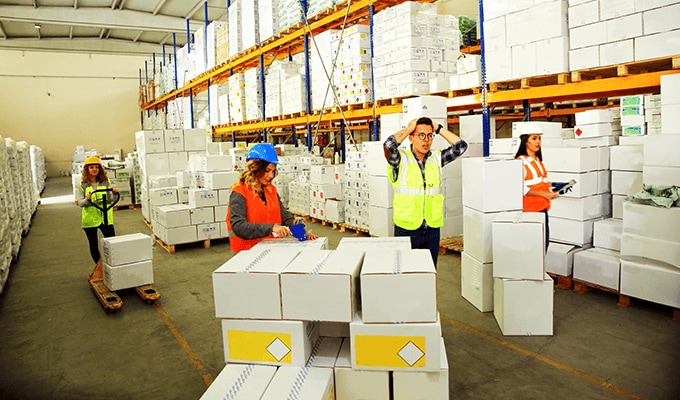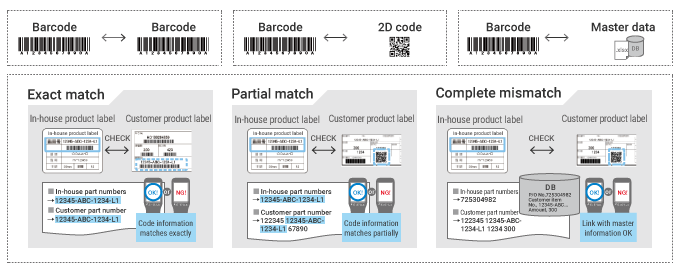Preventing Mistakes (Pokayoke)

The logistics industry has many jobs that rely on human resources, and the chance that worker-caused mistakes will occur also tends to be high. For example, incorrect shipments due to picking mistakes and selecting the wrong destination are just some examples. These mistakes lead to complaints and waste time and money to deal with if they occur. Pokayoke to prevent mistakes is what is important here. This section describes what causes mistakes to occur and how to make improvements.
Causes of Mistakes
Often times the cause of mistakes lies with people. For example, human error is a typical example, such as when products A and B are mistaken because they look similar or one digit of a long product number is missed. These might be small mistakes, but they can add up to create serious problems in operations and shipping work. Plus they may negatively impact trust relationships with customers and have a risk of large losses for corporate management. Workers should always work carefully to avoid mistakes at logistics worksites that rely on human resources.
Examples of Typical Mistakes Due to Misidentification
| Difference is too small and easy to mistake | Products look similar |
|---|---|
|
  |
| The two product numbers look the same but one digit is different so there is a risk of making a mistake. In particular, the letter O which looks like the number 0 (zero) and the letter I which looks like the number 1 (one) are easy to mistake. | Products with a similar appearance can look the same unless instructions are given ahead of time. For inexperienced operators in particular, these products are easily confused. |
Other Human Errors
The mistakes above are typical, and there are other reasons unique to humans that cause simple mistakes.
- Simple memory lapses
- Oversights and mistakes due to too much information
- Oversights of mistakes that do not stand out
- Oversights of mistakes that occur infrequently
- Mistakes and oversights by mixing up first and last information
- Mistakes and oversights caused by assumptions due to experience
This is not an exhaustive list of reasons that human errors occur. These mistakes are due to the characteristics of the human brain, and it is impossible to reduce them to zero when people are performing work.
Eliminating Mistakes

When the human brain was evolving, a function started to develop to select only the information best suited to survival. This function of the human brain is what causes simple mistakes, such as omissions and misunderstandings, to occur. The human brain easily misses fine details, so mistakes will occur no matter how carefully inspections and product inspections are carried out. Understanding this cognitive function of humans is the first step to preventing mistakes.
Specific Examples of Work Where Humans Are Weak
Each day a large amount of shipping and inspection work is performed, depending of course on the scale of the logistics center or delivery center. If this work depends on the eyes of people, then mistakes will occur. This is because the cognitive functions of humans are not suited to mechanically performing this kind of detailed work. Mistakes, such as storing goods on the wrong shelf during receiving or making a mistake with the picking list and sending an incorrect shipment, happen because humans are forced to perform work they're not well suited to. Forcibly performing this kind of work also leads to a decrease in efficiency.
- The human brain is weak at:
-
- Holding memories
- Identifying small differences
- Identifying things that do not stand out
- Processing a large volume of information at one time
- Identifying things that occur at a low frequency
Careless Mistakes
To Reduce Human Error
There are many methods available to reduce human error. Examples of these methods include taking notes, emphasizing important parts of a picking list with bold text, changing the placement of shelves so that the wrong goods are not picked, having multiple people check for errors a number of times, and reducing excess information. However, it is difficult to completely prevent mistakes even with these methods.
From the Eyes of People to the Eyes of Machines
To prevent human error, mechanization to perform the work by adhering to a program is most effective. One characteristic of machines is that they can perform work accurately that is difficult for humans, such as remembering things, identifying small differences, and identifying only things that are necessary out of a large volume of information.
For example, many errors that occur in logistics processes are eliminated by adopting handheld computers for warehousing work and inspection work. The key to pokayoke in logistics is the shift from the eyes of people to the eyes of machines.
By using handheld computers, strings of letters and numbers that are easily mistaken by humans, as well as barcodes and 2D codes that humans cannot even identify, can be accurately read to identify products and cargo. Handheld computers can compare and verify various types of information, and they can also perform checks by setting conditions such as complete match data, partial match data, and incomplete match data.
Items That Can Be Compared and Verified with Handheld Computers

Pokayoke Effect in Receiving Work
By managing products with barcodes and 2D codes, mistakenly allocating products to the wrong shelves can be prevented. Verification work can also be streamlined by managing information on PC. Visual checks become unnecessary and smooth product management can be implemented.

Increased Accuracy, Work Efficiency, and Trust from Customers
Careless mistakes can be prevented and accuracy can be increased by adopting handheld computers as mechanical eyes. Work efficiency can be increased because processes in which visual checks were made are no longer required, and stable shipping work with increased quality leads to obtaining the trust of customers.
- Increased Accuracy (Quality)

- Quality is greatly increased by accurate work that anyone can do without mistakes.
- Increased Work Efficiency (Productivity)

- Time is greatly saved in visual checks. Costs can be reduced by eliminating personnel expenses.
- Increased Trust from Customers

- Mistake-free shipping with good quality also results in increased trust from customers.





